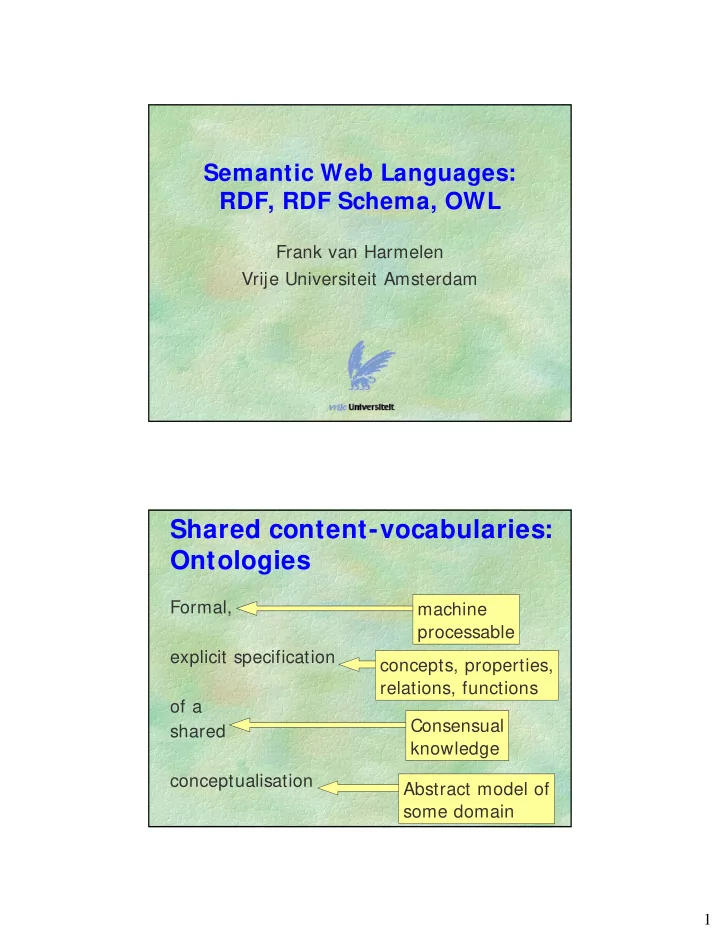

Semantic Web Languages: RDF, RDF Schema, OWL Frank van Harmelen Vrije Universiteit Amsterdam Shared content-vocabularies: Ontologies Formal, machine processable explicit specification concepts, properties, relations, functions of a Consensual shared knowledge conceptualisation Abstract model of some domain 1
What’s inside an ontology? � Classes + class-hierarchy � instances � slots/values � inheritance (multiple? defaults?) � restrictions on slots (type, cardinality) � properties of slots (symm., trans., …) � relations between classes (disjoint, covers) � reasoning tasks: classification, subsumption Stack of languages 2
Stack of languages � XML : • Surface syntax, no semantics � XML Schema : • Describes structure of XML documents � RDF : • Datamodel for “relations” between “things” � RDF Schema : • RDF Vocabulary Definition Language � OWL : • A more expressive Vocabulary Definition Language Bluffer’s guide to RDF (1) � Object -> Attribute-> Value triples Author-of pers05 ISBN... � objects are web-resources � Value is again an Object: • triples can be linked • data-model = graph Author-of Publ- pers05 ISBN... MIT by A u Publ- t h o r - o f ISBN... by 3
Bluffer’s guide to RDF (2) � Every identifier is a URL = world-wide unique naming! � Has XML syntax < rdf:Description rdf:about= “# pers05”> < authorOf> I SBN...< / authorOf> < / rdf:Description> � Any statement can be an object • graphs can be nested claims Author-of NYT pers05 ISBN... What does RDF Schema add? • Defines vocabulary for RDF • Organizes this vocabulary in a typed hierarchy • Class, subClassOf, type • Property, subPropertyOf • domain, range Person subClassOf subClassOf range domain supervises Supervisor Student type type supervises Frank Marta 4
RDF(S) syntax: graphics � Turtle <http://sem-web-primer> dc:author dc:title "Semantic Web Primer" fullname homepage "Frank van Harmelen" http://www.cs.vu.nl/~frankh RDF(S) syntax: XML <rdf:RDF> <rdf:Description rdf:about="http://sem-web-primer" dc:title="Semantic Web Primer"> <dc:author> <rdf:Description fullname="Frank van Harmelen"> <homePage rdf:resource="http://www.cs.vu.nl/~frankh"/> </rdf:Description> </dc:author> </rdf:Description> </rdf:RDF> 5
RDF(S) syntax: Turtle <http://sem-web-primer> dc:title "Semantic Web Primer" ; dc:author [ fullname "Frank van Harmelen"; homePage <http://www.cs.vu.nl/~frankh> ] . RDF(S)/ XML relationship � XML is a just a syntax for RDF(S) • (one of many) � RDF(S) assigns meaning to some terms • (XML doesn't) � This allows greater interoperability: • tools/tools • thesaurus/thesaurus • tools/thesaurus 6
Crucial RDF(S) property: � All identifiers are URL's • Allows total decoupling of • data • ontology • meta-data [<x> IsOfType <T>] meta-data different ontology data owners & locations RDF(S) is a logic � only ground binary predicates � only conjunction � limited form of ∃ (anonymous individuals) � implication between ∀ predicates (subsumption) 7
RDF(S) is a logic � (Non-standard) model-theory (Pat Hayes) • E.g: classes members of themselves � Simple model-theoretic properties: • Entailment, • skolemisation, • (strong) Herbrand property, • interpolation theorem � Axiomatisations (Stanford, Essen, Lyon) • Some of these machine verified RDF(S) have a (very small) formal semantics � Defines what other statements are implied by a given set of RDF(S) statements � Ensures mutual agreement on minimal content between parties without further contact � Sound & complete “entailment rules” � Very simple to compute (and not explosive in practice, compute full closure of > 10 9 statements) 8
Things RDF(S) can’t do � (in)equality � enumeration � boolean algebra • Union, complement � number restrictions • Single-valued/multi-valued • Optional/required values � inverse, symmetric, transitive � … Beyond RDF: OWL � OWL extends RDF Schema to a full-fledged knowledge representation language. • logical expressions • data-typing • cardinality • quantifiers � OWL is simply a Description Logic SHOIN(D) with an RDF/XML syntax 9
Layered language � OWL Lite: � Classification hierarchy Full � Simple constraints � OWL DL: DL � Maximal expressiveness � While maintaining tractability Lite � Standard formalisation � OWL Full: � Very high expressiveness � Loosing tractability Syntactic layering � Non-standard formalisation Syntactic layering Semantic layering Semantic layering � All syntactic freedom of RDF (self-modifying) Language Layers � OWL Light � (sub)classes, individuals � (sub)properties, domain, range RDF Schema � conjunction � (in)equality � cardinality 0/1 Full � datatypes � inverse, transitive, symmetric DL � hasValue � someValuesFrom Lite � allValuesFrom � OWL DL � OWL Full � Negation � Allow meta-classes etc � Disjunction � Full Cardinality � Enumerated types 10
Language Layers: Full � No restriction on use of vocabulary (as long as legal RDF) Full • Classes as instances (and much more) � RDF style model theory • Reasoning using FOL engines • via axiomatisation • Semantics should correspond with OWL DL for suitably restricted KBs Language Layers: DL � Use of OWL vocabulary restricted • Can’t be used to do “nasty things” (I.e., modify OWL) • No classes as instances DL • Defined by abstract syntax � Standard FOL model theory (definitive) • Direct correspondence with FOL • Reasoning via DL engines • Reasoning for full language via FOL engines • No need for axiomatisation (unlike full) • Would need built in datatypes for performance 11
Language Layers: Lite � No explicit negation or union � Restricted cardinality (0/1) � No nominals (oneOf) � Semantics as in DL Lite • Reasoning via DL engines (+ datatypes) • E.g., FaCT, RACER, Cerebra OWL also has a formal semantics � Defines what other statements are implied by a given set of statements � Ensures mutual agreement on content (both minimal and maximal ) between parties without further contact � Can be used for integrity/ consistency checking � Hard to compute (and rarely/sometime/always explosive in practice ) 12
Recommend
More recommend